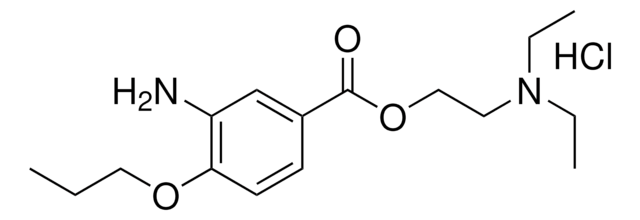T9778
Tropicamide
solid
Synonym(s):
N-Ethyl-2-phenyl-N-(4-pyridylmethyl)hydracrylamide, Ro 1-7683
About This Item
Recommended Products
form
solid
color
white
solubility
45% (w/v) aq 2-hydroxypropyl-β-cyclodextrin: 4.3 mg/mL
ethanol: 5.6 mg/mL
H2O: insoluble
storage temp.
2-8°C
SMILES string
CCN(Cc1ccncc1)C(=O)C(CO)c2ccccc2
InChI
1S/C17H20N2O2/c1-2-19(12-14-8-10-18-11-9-14)17(21)16(13-20)15-6-4-3-5-7-15/h3-11,16,20H,2,12-13H2,1H3
InChI key
BGDKAVGWHJFAGW-UHFFFAOYSA-N
Gene Information
human ... CHRM3(1131) , CHRM4(1132)
Looking for similar products? Visit Product Comparison Guide
Application
Biochem/physiol Actions
Features and Benefits
Packaging
Preparation Note
Signal Word
Warning
Hazard Statements
Precautionary Statements
Hazard Classifications
Acute Tox. 4 Dermal - Acute Tox. 4 Inhalation - Acute Tox. 4 Oral - Eye Irrit. 2 - Skin Irrit. 2 - Skin Sens. 1 - STOT SE 3
Target Organs
Respiratory system
Storage Class Code
11 - Combustible Solids
WGK
WGK 3
Flash Point(F)
Not applicable
Flash Point(C)
Not applicable
Certificates of Analysis (COA)
Search for Certificates of Analysis (COA) by entering the products Lot/Batch Number. Lot and Batch Numbers can be found on a product’s label following the words ‘Lot’ or ‘Batch’.
Already Own This Product?
Find documentation for the products that you have recently purchased in the Document Library.
Customers Also Viewed
Articles
DISCOVER Bioactive Small Molecules for Neuroscience
Our team of scientists has experience in all areas of research including Life Science, Material Science, Chemical Synthesis, Chromatography, Analytical and many others.
Contact Technical Service






